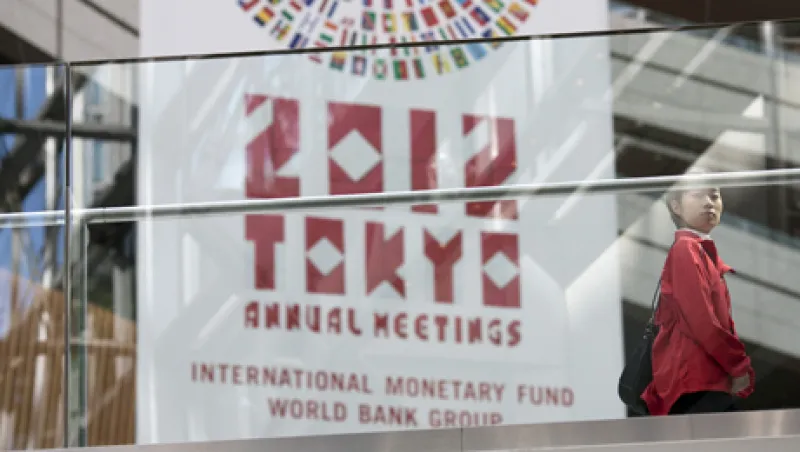Bankers, investors and policymakers struggled to get a grip on the yin and yang of global risk factors as the annual meetings of the International Monetary Fund and the World Bank got under way in Tokyo on Wednesday.
The IMF underscored the uncertainty that overshadows the world economy with its latest Global Financial Stability Report. That semiannual survey declared that financial risks had increased since April because of continuing euro zone tensions, notwithstanding the European Central Bank’s recent commitment to buy unlimited quantities of bonds from any country that reaches an economic restructuring agreement with European Union authorities. High Japanese and U.S. debt levels and a growth slowdown in emerging markets are also keeping financial risks elevated, the fund said.
The biggest casualty of the euro area debt crisis is the fragmentation of the European capital market, according to the Financial Stability Report. “Banks, insurers and nonfinancial corporations are trying to match assets, liabilities and collateral in each country of the periphery as protection against redenomination risk,” it states. “In turn, liquidity in core economy banks is not being recycled to the periphery but is instead being deposited at core central banks or in relatively safe government bonds.”
The ECB’s new bond initiative, which seeks to stem that fragmentation, is positive for markets, but it needs to be implemented, said José Viñals, director of the fund’s Monetary and Capital Markets department. That would require Spanish Prime Minister Mariano Rajoy to get off the fence. The Spanish government has so far resisted pressure from its EU partners to sign up for an EU bailout program because it would come with strict economic conditions attached.
Although spreads on Spanish and Italian government bonds have declined sharply since the ECB announced its bond initiative in August, both countries have experienced massive capital outflows and need to enact strong measures to restore investor confidence. Between June 2011 and June 2012, Spain suffered capital outflows of €296 billion ($383 billion), or 27 percent of GDP, while Italy saw €235 billion flee the country, or 15 percent of GDP, the Financial Stability Report found. As Viñals put it in an interview, “This is quite unprecedented.”
Laurence Fink, chairman and chief executive of giant fund manager BlackRock, said the outflows reflected a fundamental change in mindset. Investors used to be “tolerant” if occasional investments went bad, he told an IMF panel on sovereign risk, but following the collapse of Lehman Brothers Holdings, investors told firms like his own that “if you have a problem like that again, you will be fired.” Fear of future losses has become “an accelerant” that drives flows in financial markets, he added.
The ECB’s bond initiative has unleashed a positive dynamic in recent weeks, causing Spanish and Italian bond spreads to drop sharply, but the central bank can’t solve the debt crisis on its own, Fink said. A real resolution will require tough fiscal and structural reforms and substantial gains in competitiveness in peripheral countries, he claimed. Those goals will take a long time to achieve, he added, and governments pursuing them are likely to face many economic pitfalls and social protests along the way. “It’s going to be a seven-, eight-, nine-year process,” said Fink.
In the meantime, Europe needs other measures to facilitate its adjustment process and stimulate growth, including a weaker currency, Fink said. “A lower euro is going to be important to work this out,” he said.
The Financial Stability Report also warned about the risks of the looming U.S. fiscal cliff. If Congress fails to amend the big tax increases and spending cuts due to take effect at the start of 2013, the U.S. economy will fall into recession, it said. But few meeting participants voiced angst about the so-called cliff.
In large part that reflects confidence in the Federal Reserve Board. The Fed’s vice chairman, Janet Yellen, defended the central bank’s decision last month to embark on a third round of quantitative easing with mortgage bond purchases. “We do have weakness in the U.S. economy and expectations that this will continue for some time, which justifies the Fed’s asset purchases and is a factor that keeps long-term interest rates low,” she told the panel on sovereign risk.
Still, the IMF urged the U.S. to take action to reduce its deficit and debt in the medium term.
Viñals warned U.S. policymakers against having a “false sense of security” because of the historically low levels of rates on U.S. Treasuries. Those rates are low in part because of capital flight from the euro zone crisis. The Financial Stability Report estimates that such safe-haven flows have reduced long-term U.S. rates by at least 100 basis points; that’s broadly equivalent to the Fed’s estimate of the impact of quantitative easing. But markets could quickly reverse those moves if investors lose confidence in U.S. creditworthiness, said Viñals, adding, “It’s much, much better to take policy action before market pressures force you to.”
Japan also enjoys remarkably low interest rates despite having a public debt in excess of 220 percent of GDP, by far the largest of any major country. That’s unlikely to change any time soon given the country’s high savings rate and propensity to keep the bulk of its money at home, said Nobuyuki Hirano, president of Bank of Tokyo-Mitsubishi UFJ. The bank’s own balance sheet provides a good example, he noted. It has about ¥100 trillion ($1.3 trillion) in deposits as liabilities and about ¥60 trillion in loans as assets. The remaining ¥40 trillion in assets are mostly comprised of Japanese government bonds (JGBs), he said.
Although Japan’s savings rate is likely to decline eventually as the population ages, for now JGBs “are relatively immune to overseas markets,” Hirano said.






